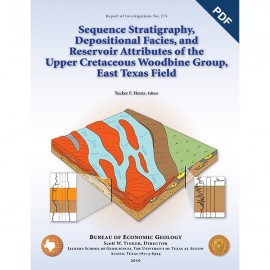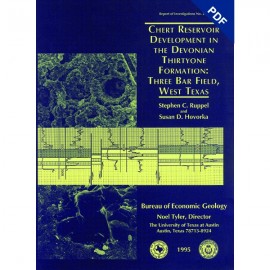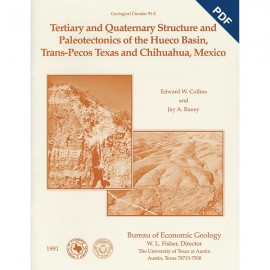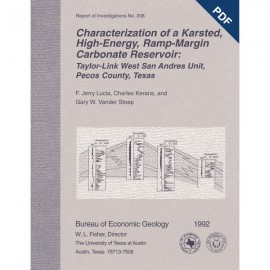Reports of Investigations
-
Books & Reports
- Reports of Investigations
- Guidebooks
- Udden Series
- Geological Circulars
- Down To Earth
- Atlases of Major Oil and Gas Reservoirs
- Texas Memorial Museum Publications
- Environmental Geologic Atlas of the Texas Coastal Zone
- Mineral Resource Circulars
- Other Reports
- Seminars and Workshops
- Handbooks
- Submerged Lands of Texas
- Symposia
- Annual Reports
- Open File Reports
-
Maps & Cross Sections
- Thematic Maps
- Miscellaneous Maps, Charts & Sections
- Geologic Atlas of Texas
- STATEMAP Project Maps
- Geologic Quadrangle Maps
- Cross Sections
- Highway Geology Map
- Energy and Mineral Resource Maps
- Shoreline Change and Other Posters
- Wilcox Group, East Texas, Geological / Hydrological Folios
- Bouguer Gravity Atlas of Texas
- River Basin Regional Studies
- Featured Maps
- Posters
- Teachers & the Public
-
Geological Society Publications
- Gulf Coast Association of Geological Societies
- Alabama Geological Society
- Austin Geological Society
- Corpus Christi Geological Society
- Houston Geological Society
- Lafayette Geological Society
- Mississippi Geological Society
- New Orleans Geological Society
- South Texas Geological Society
- GCS SEPM Publications
- Historic BEG & UT Series
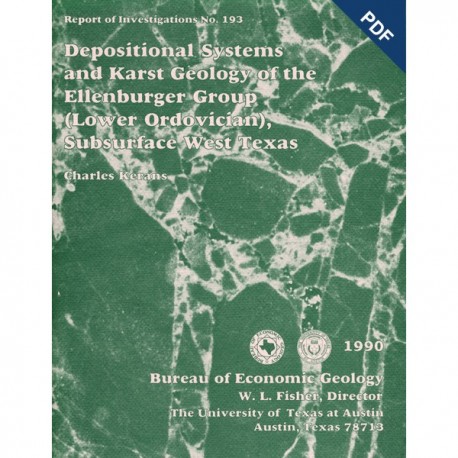
Depositional Systems and Karst Geology of the Ellenburger Group..., Subsurface West Texas. Digital Download
RI0193D
Depositional Systems and Karst Geology of the Ellenburger Group (Lower Ordovician), Subsurface West Texas, by Charles Kerans. 63 p., 37 figs., 2 tables, 1 appendix, 6 pls., 1990. doi.org/10.23867/RI0193D. Digital Version.
For a print version: RI0193.
RI0193D. Depositional Systems and Karst Geology of the Ellenburger Group (Lower Ordovician), Subsurface West Texas, by Charles Kerans. 63 p., 37 figs., 2 tables, 1 appendix, 6 pls., 1990. doi.org/10.23867/RI0193D. Downloadable PDF.
To purchase this product in book format, please order RI0193.
ABSTRACT
The Ellenburger Group (Lower Ordovician) of Texas is a laterally extensive peritidal carbonate shelf sequence. It forms a major deep oil reservoir, having estimated reserves of 1.15 billion barrels of oil, and it also contains an estimated 2.2 billion barrels of oil equivalent. Despite its economic and geologic significance, comparatively little is known about the subsurface Ellenburger in West Texas; thus, this study presents a regional model of Ellenburger deposition and diagenesis.
Six depositional systems, based on associations of lithologies and sedimentary structures observed in core, were recognized in the Ellenburger: (1) fan delta-marginal marine (litharenite); (2) lower tidal-flat. (mixed silliciclastic-carbonate packstone-grainstone); (3) high-energy restricted-shelf (ooid-peloid grainstone); (4) low-energy restricted-shelf (mottled mudstone); (5) upper tidal-flat (laminated mudstone); and (6) open shallow-water shelf (packstone-grainstone). The first two depositional systems record retrogradational sedimentation during initial transgression. The high-energy restricted-shelf system forms a laterally extensive sheet throughout most of Central and West Texas and represents relatively rapid and widespread flooding of the shelf. The latter three depositional systems record gradual progradational or aggradational sedimentation, or both. The open shallow-water shelf depositional system occurs as a broad fringe along the cratonward margin of the Ouachita foldbelt, and it represents the most open marine conditions on the shelf during middle to late Ellenburger sedimentation.
Evidence of subaerial exposure and karst development is ubiquitous in Ellenburger carbonates. The most prolific karst event occurred prior to deposition of the Middle Ordovician Simpson Group associated with a global eustatic sea-level lowstand. This karst system is represented by fracture, mosaic, and chaotic breccias, and siliciclastic and carbonate infill sediments. Karst collapse breccias locally extend more than 600 ft (200 m) below the Ellenburger-Simpson contact, and laterally extensive phreatic cave systems developed between 30 and 300 ft (10 and 300 m)below this unconformity. Additional local karst development occurred in the Silurian-Devonian, Mississippian, and Pennsylvanian Periods.
Diagenesis of the Ellenburger Group was dominated by three major styles of dolomitization. Very fine crystalline dolomite (5-20um) is restricted to tidal-flat facies and is interpreted to be a penecontemporaneous replacement fabric. Fine to medium crystalline dolomite (20-100 um), which is widespread in all facies, probably resulted from regionally extensive reflux processes operative during Ellenburger sedimentation. Coarse crystalline replacement mosaic dolomite and saddle dolomite cement formed in a burial setting after pre-Simpson karst formation and before Pennsylvanian faulting, uplift, and erosion. Other diagenetic events were karst-related dissolution episodes associated with repeated uplift and exposure of the Ellenburger platform and subsequent dedolomitization.
The most common porosity type in Ellenburger reservoirs occurs in fractures and brecciated dolostones within paleokarst collapse zones. These porosity zones may be continuous from the upper Ellenburger erosion surface downward, or they may be represented by impermeable cave-infill sediments, resulting in vertical reservoir compartmentalization. Other porosity types are late, tectonically generated fracture porosity and vuggy and intercrystalline porosity produced during burial dolomitization, particularly in the high-energy restricted-shelf depositional system.
Keywords: carbonate facies, depositional systems, diagenesis, Ellenburger Group, karst, Lower Ordovician reservoirs, West Texas
CONTENTS
Abstract
Introduction
Regional Geologic Setting
Previous Work
Depositional Systems and Facies Analysis
Sedimentary Facies and Depositional Systems
Fan Delta - Marginal Marine Depositional System
Lower Tidal-Flat Depositional System
High-Energy Restricted-Shelf Depositional System
Low-Energy Restricted-Shelf Depositional System
Upper Tidal-Flat Depositional System
Open Shallow-Water Shelf Depositional System
Depositional History
Regional Depositional Setting
Paleokarst Features
Middle 0rdovician Unconformity
Age Relationships at the Unconformity
Paleotopography
Paleokarst Deposits
Fracture and Mosaic Breccias
Chaotic Breccias
Vertical Distribution of Paleokarst Deposits
Lateral Distribution of Paleokarst Deposits
Regional Distribution of Paleokarst Deposits
Model of Middle Ordovician Paleokarst
Silurian-Devonian Paleokarst Features
Carboniferous Paleokarst Features.
Nature of Carboniferous Paleokarst.
Diagenetic History
Marine Components
Early Diagenetic Phases
Dolomitization
Very Fine Crystalline Dolomite
Fine to Medium Crystalline Dolomite
Coarse Crystalline Dolomite
Other Late-Stage Diagenetic Phases
Summary of Diagenetic History
Implications for Petroleum Exploration and Production Conclusions
Acknowledgments
References
Appendix: Core Examined in This Study (in inside back pocket of book)
Figures
- Location map showing cores and lines of cross section studied. tectonic features, and Ellenburger and El Paso Group outcrops
- Map showing regional depositional setting during
- Isopach map of the Ellenburger Group
- Simplified regional cross section of the Permian Basin
- Schematic representation of depositional systems in West Texas compared with formalized Ellenburger stratigraphy in the Llano area
- Graphic log of fan delta -marginal marine depositional system, Phillips Puckett No. 1- C well, Pecos County
- Core photographs of fan delta -marginal marine depositional system
- Graphic log of lower tidal-flat depositional system, Gulf Keystone 108-E well, Winkler County
- Core photographs of lower tidal-flat depositional system
- Graphic log of high-energy restricted-shelf depositional system, Gulf McElroy St. No. 1 well, Upton County
- Core photographs and photomicrograph of high-energy restricted-shelf depositional system
- Graphic log of low-energy restricted-shelf depositional system, Phillips Glenna No. 1 well, Pecos County
- Core photographs of low-energy restricted-shelf depositional system
- Graphic log of upper tidal-flat depositional system, Phillips Puckett No. 1-6 well, Pecos County
- Core photographs of upper tidal-flat depositional system, Magnolia Below No. 1 well, Kendall County
- Graphic log of open shallow-water shelf depositional system, Humble Alma Cox No. 1-D well, Crockett County
- Core photograph and photomicrograph of open shalllow-water shelf depositional system
- Generalized cross section showing distribution of depositional systems in a section oriented oblique to depositional strike
- Schematic illustration of principal depositional and erosional phases exhibited by the Ellenburger Group
- Subcrop map of Ellenburger depositional systems showing progressively deeper erosion toward the northwest
- Schematic reconstruction of early Middle Ordovician paleogeography of North America
- Schematic representation of breccia types in Ellenburger paleokarst deposits
- Typical examples of Ellenburger paleokarst breccias
- Typical infill deposits of the Ellenburger paleokarst system
- Core photographs, Gulf McElroy St. No. 1 well, Upton County
- Gamma-ray, neutron, and graphic logs showing distribution of fracture-brecciated roof zone, cave-infill zone, and lower collapse breccia zone in Gulf McElroy St. No. 1well, Upton County
- Gamma-ray, spontaneous potential, resistivity, and graphic logs showing distribution of paleokarst deposits, Gulf TXL 000-1 well, Emma field, Andrews County
- Core photographs of paleokarst features, Gulf TW, 000-1 well, Andrews County
- Gamma-ray, spontaneous potential, resistivity, and graphic logs showing character and distribution of Ellenburger paleokarst breccias, Phillips Wilson No. 1 well, Val Verde County
- Spontaneous potential and resistivity log cross section of the northern Andector Ellenburger reservoir showing the lateral continuity of the infill zone
- Schematic model of development of Ellenburger paleokarst deposits
- Core photographs of paleokarst features associated with the pre-Pennsylvanian unconformity in the upper 40 ft (12 m) of the Houston Oil and Minerals Co. Brown B-8-1 well
- Photomicrograph of marine components and eogenetic diagenetic fabrics
- Photomicrographs of very fine crystalline and fine to medium crystalline dolomite generations
- Photomicrographs of coarse crystalline dolomite
- Photomicrographs of late diagenetic textures postdating or intergrown with coarse crystalline dolomite generation
- Sequence of diagenetic events recorded in Ellenburger carbonates
Tables
1. Characteristics of Ellenburger depositional systems
2. Comparison of fault-related and karst breccias
Plates (in inside back pocket of book)
1. West-east cross section, Lipscomb to Montague Counties
2. West-east cross section, Andrews County
3. West-east cross section, Winkler to Brown Counties
4. West-east cross section, Winkler to Reagan Counties
5. West-east cross section, Presidio to Schleicher Counties
6. West-east cross section, Val Verde to Kendall Counties
Citation
Kerans, Charles, 1990, Depositional Systems and Karst Geology of the Ellenburger Group (Lower Ordovician), Subsurface West Texas: The University of Texas at Austin, Bureau of Economic Geology, Report of Investigations No. 193, 63 p.

